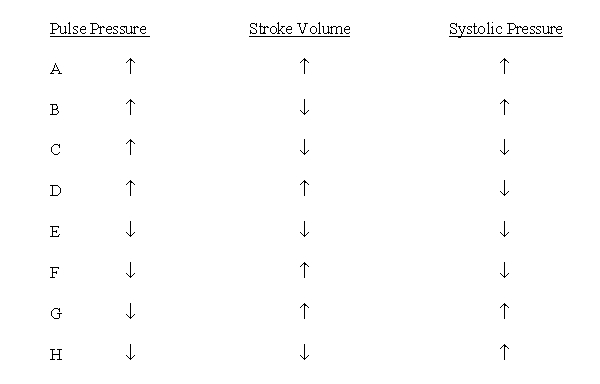Deck 15: Vascular Distensibility and Functions of the Arterial and Venous Systems
سؤال
سؤال
سؤال
سؤال
سؤال
سؤال
سؤال
سؤال
سؤال

فتح الحزمة
قم بالتسجيل لفتح البطاقات في هذه المجموعة!
Unlock Deck
Unlock Deck
1/9
العب
ملء الشاشة (f)
Deck 15: Vascular Distensibility and Functions of the Arterial and Venous Systems
1
A 60-year-old man visits his family practitioner for his yearly examination. He has a blood pressure of 180/100 mm Hg, a heart rate of 78 beats/min, and a pulse pressure of 80 mm Hg. His plasma cholesterol level is in the upper 25th percentile. A decrease in which of the following is the most likely explanation for the high pulse pressure in this patient?
A)Stroke volume
B)Arterial pressure
C)Heart rate
D)Arterial compliance
E)Total peripheral resistance
A)Stroke volume
B)Arterial pressure
C)Heart rate
D)Arterial compliance
E)Total peripheral resistance
D
2
Which one of the following would increase venous hydrostatic pressure in the legs?
A)Decrease in right atrial pressure
B)Pregnancy
C)Movement of leg muscles
D)Hemorrhage
A)Decrease in right atrial pressure
B)Pregnancy
C)Movement of leg muscles
D)Hemorrhage
B
3
Which of the following components of the circulatory system has the largest distribution of blood volume?
A)Arteries
B)Capillaries
C)Veins
D)Pulmonary circulation
E)Heart
A)Arteries
B)Capillaries
C)Veins
D)Pulmonary circulation
E)Heart
C
4
A 65-year-old man with a 5-year history of severe congestive heart failure who takes an angiotensin converting enzyme inhibitor visits a clinic with a complain of swelling in his legs. Which of the following set of changes would explain the swelling? 


فتح الحزمة
افتح القفل للوصول البطاقات البالغ عددها 9 في هذه المجموعة.
فتح الحزمة
k this deck
5
Which one of the following tends to decrease pulse pressure?
A)Increase in metabolic rate
B)Increase in stroke volume
C)Increase in arterial compliance
D)Increase in venous return
E)Increase plasma volume
A)Increase in metabolic rate
B)Increase in stroke volume
C)Increase in arterial compliance
D)Increase in venous return
E)Increase plasma volume

فتح الحزمة
افتح القفل للوصول البطاقات البالغ عددها 9 في هذه المجموعة.
فتح الحزمة
k this deck
6
A 24-year-old woman delivers a 6-pound, 8-ounce female infant. The newborn is diagnosed with patent ductus arteriosus. Which set of changes would be expected in this patient? 


فتح الحزمة
افتح القفل للوصول البطاقات البالغ عددها 9 في هذه المجموعة.
فتح الحزمة
k this deck
7
A 35-year-old woman visits her family practitioner for an examination. She has a mean blood pressure of 105 mm Hg and a heart rate of 74 beats/min. Further tests by a cardiologist revealed that the patient has moderate aortic valve stenosis. Which one of the set of changes would be expected in this patient? 


فتح الحزمة
افتح القفل للوصول البطاقات البالغ عددها 9 في هذه المجموعة.
فتح الحزمة
k this deck
8
Which one of the following parts of the circulation has the highest compliance?
A)Capillaries
B)Venules
C)Veins
D)Aorta
E)Arteries
A)Capillaries
B)Venules
C)Veins
D)Aorta
E)Arteries

فتح الحزمة
افتح القفل للوصول البطاقات البالغ عددها 9 في هذه المجموعة.
فتح الحزمة
k this deck
9
A 65-year-old man has congestive heart failure. He has a cardiac output of 4.0 L/min, arterial pressure of 115/85 mm Hg, and a heart rate of 90 beats/min. Further tests by a cardiologist reveal that the patient has a right atrial pressure of 10 mm Hg. An increase in which of the following would be expected in this patient?
A)Plasma colloid osmotic pressure
B)Interstitial colloid osmotic pressure
C)Arterial pressure
D)Cardiac output
E)Vena cava hydrostatic pressure
A)Plasma colloid osmotic pressure
B)Interstitial colloid osmotic pressure
C)Arterial pressure
D)Cardiac output
E)Vena cava hydrostatic pressure

فتح الحزمة
افتح القفل للوصول البطاقات البالغ عددها 9 في هذه المجموعة.
فتح الحزمة
k this deck








